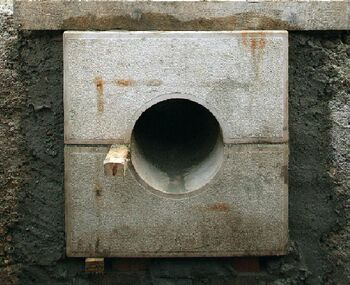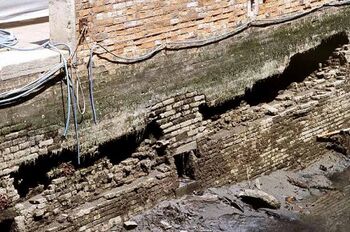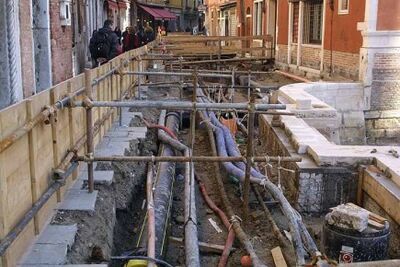Sewage disposal

Sewage disposal is the process in which sewage is transported through cities and inhabited areas to sewage treatment plants, where it is then treated to remove contaminants to produce environmentally-safe waste. Disposal of sewage waste protects public health and prevents disease as well as water pollution from sewage contaminants. Many modern cities have sewage disposal systems, and advancing technology has allowed for more environmentally friendly and healthy solutions to disposing and treating sewage. Sewage systems are part of modern infrastructure and urban utilities, which also include gas, electric, and water supply.
Venice is very unique in terms of its sewage disposal; the canals are the main way waste is disposed of in Venice, though new technology has improved the sewage aspect of Venice's infrastructure. However, bringing a more modern, efficient sewage disposal system to Venice is a challenge that currently has many obstacles.
History
Venice has been, historically, one of Europe’s cleanest cities. 15th-century Venetians dealt with their waste by flinging it out into the streets, as many medieval people did; Venice's streets were made of water, however, and the tides conveniently swept waste out to sea twice a day. [1] This kept Venice clean of waste compared with other cities, utilizing the power of the tides and Venice’s nature as a city of water to remove waste long before modern sewage disposal systems existed. As a result, Venice developed one of the first sewer systems to be implemented in the world; the unique, gravity-driven system of underground channels and waste water drainage is called a fognatura.[2]

In the 16th century, a network of tunnels was put in place in the walls and under the pavement of walkways in Venice to collect waste water and rain water. These tunnels, called “gatoli,” collected and channeled the city’s waste water, which would then flow out into the waters of the lagoon.[3] Gatoli are still present in Venice today as a means of channeling waste away from the city; however, they are centuries old, and are becoming damaged or falling apart in addition to not being able to handle the high number of people always present in modern Venice. Additionally, the physical outlets where sewage waste enter the canals, called sbocchi, are as old as the Venetian foundations they are in, and are in disrepair as well, as seen in the picture on the left where a sboccho in a highly damaged canal wall is revealed during canal maintenance by Insula S.p.A..
The use of canals as a sewage disposal system in Venice has come to an unpleasant surprise to the visitors and tourists of Venice for hundreds of years, and the stereotype of Venice's water as filthy and dangerous is just as old.[1] The presence of sewage in the canals contributes to the unpleasant smell that tourists complain of, and locals often attribute the smell to "naturally occurring algae and silt" in the canals, though the sewage is the real culprit. Venice's antiquated sewage system is very different from modern sewer systems found in other urban areas around the world, which is part of why tourists are so shocked and exaggerate the smell. Local Venetians ignore the stench of the canals as they are simply used to it.
Modern Day
The main sewage disposal system in Venice today continues to be the canals and naturally occurring tides. As new technology has become available, newer forms of sewage disposal have been implemented. However, these changes have not been made throughout the whole city, and not uniformly to all of Venice's buildings, so the current sewage disposal system is a patchwork of old and new and still does not fully function to the city's needs. The edges of the physical city and the peripheral islands, such as the areas of St. Helena, Giudecca, Santa Marta, and Murano, have more modern networks of sewage disposal, but many still dispose directly into the lagoon's waters. A central sewage treatment plant was built in Porto Marghera in the 1980s, but it is far removed from the main center of the city of Venice. Sewage is removed and treated there when possible, but some sewage continues to enter directly into the canals. Venice has 140 small biological plants installed throughout the city for waste treatment, and more than 6,000 septic tanks.[4] Private residences and businesses such as hotels are required to have their own septic tanks in Venice to help alleviate some of the problems caused by sewage, but the sheer number of people and amount of sewage plus the outdated sewage systems have been causing a variety of problems in Venice.
Sewage Problems
Venice's sewage problems are twofold: a lack of proper treatment of sewage poses a threat to public health, and the network of tunnels and channels that currently exist as the main sewage disposal system in Venice can cause structural damage to the city.
Health Risks
The Veneto region, where Venice is located, has only 70% wastewater treatment coverage as a whole, and Venice in particular has a lack of sufficient sewage networks.[5] Venice's 16th-century sewage system of the gatoli and canals, while once revolutionary, is now outdated and inadequate for a modern city. Some houses and apartments still discharge sewage directly into the canals of Venice without treatment other than the removal of solids.[6] Health standards have increased in modern times, and directly depositing sewage into the canals is unsanitary and even dangerous, as the sewage contaminates the canals' water with bacteria and other contaminates hazardous to humans. Significant levels of hepatitis A and enteroviruses have been detected in Venice's canals in relation to the lack of proper sewage treatment, and even though swimming in the canals is forbidden, the seasonal flooding in Venice exposes tourists and locals to the dangers of untreated sewage.[5] Not only is the presence of sewage in the canals revolting to tourists, it threatens public health in this historic city.
Structural Risks
Venice's antiquated sewage disposal system also threatens the structural integrity of the foundations and canal walls throughout the city. The disposal of sewage directly into the canals contributes to sedimentation, the long-term buildup of sediments and solids in the canals. The buildup of sediment over time can cause the canals to become so shallow during low tides that they become impassable. Additionally, if the sedimentation blocks the sewage outlets of the buildings adjacent to the canals, the outlets can burst and cause severe damage. The foundations of these buildings become flooded with sea water and sediment, which damages not only the masonry and mortar, but also the other infrastructure systems in place. In 1999, a study of the sedimentation in Venice determined that 12 percent of all sediments in the canals come from sewage discharge, a significantly large amount. [7] Sedimentation from sewage is one of the main causes of canal wall damage in this way, a direct result of the inadequate sewage system in Venice.
Maintenance, Research & Plans
The City of Venice has been working on solving the sewage-related problems in Venice. Current preventative maintenance helps the current state of the canals, research in Venice has helped identify possible solutions to the difficult nature of sewage systems in Venice, and future plans hope to solve the issues created by a lack of an adequate sewage system.

Maintenance
Maintenance performed on the canals of Venice tie directly to the sewage outlets present in the canal walls, and help alleviate some of the problems caused by sewage. Insula, the city's maintenance consortium, does a wide variety of maintenance projects including work to the canals and sewer system. Insula dredges Venice's canals to get rid of the damaging sedimentation that has built up over the years, and repairs the infrastructure that has been damaged by sediment buildup. Additionally, Insula repairs canal walls and sewer outlets that have deteriorated over time, sealing sewer pipes to prevent the tides from causing deterioration.[8] Insula has done adaptations to the current sewage disposal system as well, optimizing it for better function that will be easier to maintain and cause less of the sewage-related problems present in Venice. The sbocchi, originally at 1.8 meters below the zero sea level, were rebuilt higher at 1.3 meters and 0.8 meters to ensure they function correctly. Once this sewage is discharged into the canals, however, the system is still dependent on the tides to carry the sewage from the city out to sea. Preventative maintenance can only do so much for the current sewage system and the buildup of sediments in Venice's canals.
Research
Much research has been done to look into the Venetian sewage disposal system and ways it has affected the city as well as ways to improve it. A 1999 project investigated the sedimentation issue resulting in part from the disposal of sewage directly into the canals, and in 1997 a project studied the possible use of a HIFLO Vacuum Sewage System within the city as a new sewage disposal solution.[9] This type of sewage system is specifically designed to handle high volumes of sewage that are produced in high density population areas in cities. Research such as these projects have taken steps towards understanding the nature of the sewage problems in Venice and ways they can be successfully addressed.
Plans
Insula and the city of Venice have continued plans for regular maintenance of Venice infrastructure, including its sewage disposal system. However, large renovations and changes to the existing system are difficult because of the age of the system, the variety of different systems implemented in different parts of the city, and the need to preserve Venice's historic areas while doing maintenance projects. Insula has dedicated itself to maintaining Venice while preserving the historical and cultural integrity of its structures, putting stones back exactly as they were before maintenance, but installing new systems becomes very difficult because of this. Modern sewage systems like those present in other cities are not an option for Venice, and Venetian officials are working with limited funding in addition to the preservation obstacle in bringing a newer, more adequate sewage disposal system to Venice.
See Also
References
- ↑ 1.0 1.1 Robert C. Davis and Garry R. Marvin (2004). Venice, the Tourist Maze.
- ↑ "Fognatura". http://it.wikipedia.org/wiki/Fognatura.
- ↑ "Insula". 2010. http://www.insula.it/index.php/attivita-servizi/infrastrutture-urbane-e-viabilita/179-adeguamento-e-rinnovo-del-sistema-fognario.
- ↑ "10th Specialized Conference on Small Water and Wasterwater Systems, International Water Association". http://www.iwahq.org/nl/events/iwa-events/2011/small-water-systems-2011.html.
- ↑ 5.0 5.1 Michael G. Donovan (2010). OECD territorial reviews; Venice, Italy 2010. OECD Publishing.
- ↑ "Safeguarding Venice". http://pubs.acs.org/cen/coverstory/7835/7835sci1.html.
- ↑ Alexander Borrelli, Matthew Crawford, James Horstick, and Izzettin Halil Ozbas (1999). Quantification of Sediment Sources in the City of Venice, Italy. Interactive Qualifying Project, Worcester Polytechnic Institute.
- ↑ "Insula, Infrastrutture urbane e Viabilità". 2010. http://www.insula.it/index.php/attivita-servizi/infrastrutture-urbane-e-viabilita.
- ↑ Martin Felices, Lauren Goodfellow, Jay Johnston, and Sonali Maheshwary (1997). A Preliminary Study of a HIFLO Vacuum Sewage System within the city of Venice, Italy. Interactive Qualifying Project, Worcester Polytechnic Institute.